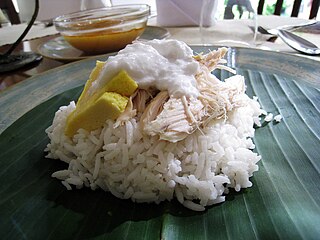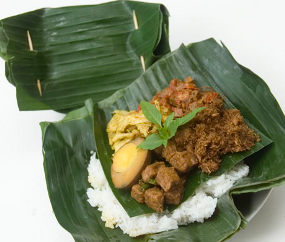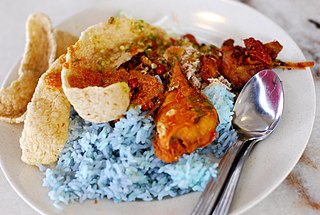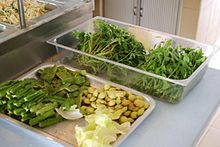
Malaysian cuisine consists of cooking traditions and practices found in Malaysia, and reflects the multi-ethnic makeup of its population. The vast majority of Malaysia's population can roughly be divided among three major ethnic groups: Malays, Chinese and Indians. The remainder consists of the indigenous peoples of Sabah and Sarawak in East Malaysia, the Orang Asli of Peninsular Malaysia, the Peranakan and Eurasian creole communities, as well as a significant number of foreign workers and expatriates.

Nasi lemak is a dish originating in Malay cuisine that consists of fragrant rice cooked in coconut milk and pandan leaf. It is commonly found in Malaysia, where it is considered as the national dish. It is also a native dish in neighbouring areas with significant ethnic Malay populations such as Singapore and Southern Thailand. In Indonesia, it can be found in several parts of Sumatra, especially the Malay regions of Riau, Riau Islands and Medan. It is considered an essential dish for a typical Malay-style breakfast. Nasi lemak is featured as a national dish in most of the country's tourism brochures and promotional materials.

Indonesian cuisine is a collection of various regional culinary traditions that formed in the archipelagic nation of Indonesia. There are a wide variety of recipes and cuisines in part because Indonesia is composed of approximately 6,000 populated islands of the total 17,508 in the world's largest archipelago, with more than 1,300 ethnic groups.

Laksa is a spicy noodle dish popular in Southeast Asia. Laksa consists of various types of noodles, most commonly thick rice noodles, with toppings such as chicken, prawn or fish. Most variations of laksa are prepared with a rich and spicy coconut soup or a broth seasoned with sour asam.

Malay cuisine is the traditional food of the ethnic Malays of Southeast Asia, residing in modern-day Malaysia, Indonesia, Singapore, Brunei, Southern Thailand and the Philippines as well as Cocos Islands, Christmas Island, Sri Lanka and South Africa.

Fried rice is a dish of cooked rice that has been stir-fried in a wok or a frying pan and is usually mixed with other ingredients such as eggs, vegetables, seafood, or meat. It is often eaten by itself or as an accompaniment to another dish. Fried rice is a popular component of East Asian, Southeast Asian and certain South Asian cuisines, as well as a staple national dish of Indonesia. As a homemade dish, fried rice is typically made with ingredients left over from other dishes, leading to countless variations. Fried rice first developed during the Sui Dynasty in China.

Nasi goreng is a Southeast Asian fried rice dish, usually cooked with pieces of meat and vegetables. One of Indonesia's national dishes, it is also eaten in Malay-speaking communities in countries such as Malaysia, Singapore and Brunei, and has gained popularity in Sri Lanka through migrations from the Indonesian Archipelago, in countries like Suriname via Indonesian immigrant communities, and in the Netherlands through its colonial ties with Indonesia. Nasi goreng is distinguished from other Asian fried rice preparations by its distinct smoky aroma, and caramelised yet savoury undertones of flavour. There is no single defined recipe for nasi goreng, and its composition and preparation varies greatly from household to household.

Pecel is a traditional Javanese salad with peanut sauce, usually eaten with carbs.

Nasi dagang is a Malaysian dish consisting of rice steamed in coconut milk, fish curry and extra ingredients such as pickled cucumber and carrots.

Lontong is an Indonesian dish made of compressed rice cake in the form of a cylinder wrapped inside a banana leaf, commonly found in Indonesia, Malaysia, and Singapore. Rice is rolled inside a banana leaf and boiled, then cut into small cakes as a staple food replacement for steamed rice. The texture is similar to that of ketupat, with the difference being that the ketupat container is made from woven janur fronds, while lontong uses banana leaf instead.

Nasi pecel also known as Sega pecel in Javanese is an Indonesian rice dish from Java served with pecel. The vegetables are usually kangkung or water spinach, long beans, cassava leaves, papaya leaves, and in East Java often used kembang turi. It is often eaten with fried tempeh and traditional crackers called peyek. It is popular in East and Central Java.

Nasi liwet is an Indonesian dish rice dish cooked in coconut milk, chicken broth, and spices, from Solo, Central Java, Indonesia. Common steamed rice is usually cooked in water, but nasi liwet is rice cooked in coconut milk, chicken broth, salam leaves, and lemongrass, thus giving the rice a rich, aromatic, and succulent taste. Nasi liwet is a traditional Javanese way of cooking rice in coconut milk. There is one variant of liwet rice, the style of Nasi Liwet Sunda from West Java with its unique Sundanese cuisine a different taste and presentation from the Sundanese eating tradition called ngeliwet or botram.

Nasi bogana or nasi begana, pronounced as nah-see boh-gâna, is an Indonesian-style rice dish, originally from Tegal, Central Java. It is usually wrapped in banana leaves and served with side dishes.

Nasi ulam is a traditional Indonesian dish of steamed rice (nasi) served with various herbs and vegetables (ulam).

Nasi kerabu is a Malaysian rice dish, a type of nasi ulam, in which blue-colored rice is eaten with dried fish or fried chicken, crackers, pickles and other salads. The blue color of the rice comes from the petals of Clitoria ternatea (butterfly-pea) flowers (bunga telang), which are used as a natural food coloring in cooking it. The rice can also be plain white rice or rice cooked using turmeric. It is often eaten with solok lada and is also eaten with fried keropok.

Betawi cuisine is rich, diverse and eclectic, in part because the Betawi people that create them were composed from numbers of regional immigrants that came from various places in the Indonesian archipelago, as well as Chinese, Indian, Arab, and European traders, visitors and immigrants that were attracted to the port city of Batavia since centuries ago.

Kerutuk daging or daging masak kerutuk is a traditional food in Kelantan, Malaysia.

Nasi minyak is an Indonesian dish from Palembang cuisine of cooked rice with minyak samin (ghee) and spices. This rice dish is commonly associated with Palembang city, the capital of South Sumatra province. However, it is also common in neighboring Jambi as far north to Medan in North Sumatra. Nasi minyak looks and tastes similar to nasi kebuli, this is because both rice dishes are influenced by Indian and Middle Eastern cuisines, as evidence in the use of ghee and certain spices. Bumbu spice mixture being used including cardamom, anise, clove, caraway, cinnamon, onion, garlic and curry powder.

Arab Indonesian cuisine is characterized by the mixture of Middle Eastern cuisine with local Indonesian-style. Arab Indonesians brought their legacy of Arab cuisine—originally from Hadhramaut, Hejaz and Egypt—and modified some of the dishes with the addition of Indonesian ingredients. The Arabs arrived in the Nusantara archipelago to trade and spread Islam. In Java, since the 18th century AD, most of Arab traders settled on the north coast and diffuse with indigenous, thus affecting the local cuisine culture, especially in the use of mutton meat and ghee in cooking.

Nasi kari is an Indonesian rice dish from Acehnese, Minangkabau and Malay as well as Javanese cuisine. This rice dish is popular in Sumatra and Java, Indonesia.



















